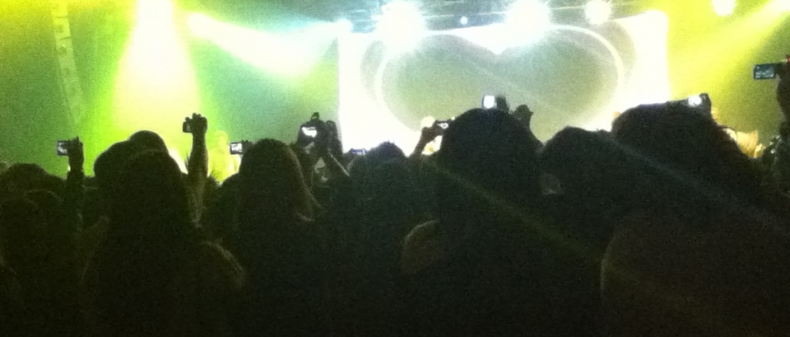
The crowd at last month’s K-Pop Wave concert
In March, before the first day of Canadian Music Fest, I went to the Royal York Hotel to pick up my ticket for the following evening’s K-Pop Wave-Seoulsonic showcase at the Kool Haus. The concert was half a showcase for some Korean teen idols (a girl group, a boy group, and two singers) and half a concert stop for three Korean rock bands that had been touring North America together under the “Seoulsonic” aegis. The envelope said “1 x K-POP”, and I immediately stuffed it into my bag as some other festival-goers walked by behind me. Could they see the word “K-POP”? What would they think of me?
For the uninitiated, the K in K-pop does indeed stand for “Korean,” as in its country of origin and the language it’s mostly sung in (with some English phrases added for flavour here and there). The term is often used as if it were a genre, all pitched-up synths, accelerated dance beats and syrupy vocals, but it’s really an industry, and a highly industrialized, vertically integrated one at that, as SPIN writer David Bevan detailed in his recent feature on the business side of K-pop.
I began listening to Korean pop in 2009 and blogging about it in 2010, but it’s taken me until the past few months to start talking about it openly in public, which just happened to coincide with increased attention from Western-oriented music publications like SPIN and Pitchfork, along with appearances by K-pop groups on Nickelodeon and David Letterman. K-pop is trending. It generates page views (ahem) and gets name-dropped as an influence by au courant artists like Grimes. This is good news for the industry back in South Korea, not because they need our validation but because they’ve continually tried to cross over here (or, more specifically, in the U.S.) since back when receiving Flo Rida’s endorsement was considered a good thing. But there are always early adopters, in this case the several thousand international fans scattered across North America (with more in Europe, South America, and Southeast Asia).
Yet I didn’t know what or who an international K-pop fan really was. I knew that in its native country, being a fan was almost as big a deal as being a performer, with official group nouns and chants and even colours; but I didn’t know what my own tribe was, those from non-Korean-speaking places who listened to it on a regular basis and kept up with the industry, except other people who read about it on the Internet. I was used to attending concerts, but I assumed that many of K-pop’s online fans would not be. Though David Bevan’s piece ends with a 2NE1 concert in New York, he makes few notes on who’s attending beyond “entire Korean-American families.”
As it turns out, the prospect of seeing a K-pop group perform live was a big draw for many people, and not just large Korean families. When I arrived at the Kool Haus an hour before the doors opened, the line was already extending around the block and up Lower Jarvis. I figured this was typical for a pop concert, but I was still surprised by the number of people. Most looked to be under 30, with the occasional parental chaperone thrown in. The ethnic mix was diverse, too: there was a large East Asian contingent, to be sure, but also white, black, Middle Eastern, and Southeast Asian. Two girls lined up in front of me had a conversation in Spanish. The styles of dress ranged from standard Parkdale to something approximating Japanese street fashion.
Some people were clearly there to see a specific group–I saw a group of teenagers dressed like boy band Teen Top in their recent promo photos, wearing aviator sunglasses and leather jackets–but others were there simply to show their support. One woman, Justine, had driven in from Windsor with a friend, but not for anyone in particular. “I was so surprised to hear about this show. I saw an ad for it on Facebook and went, ‘What? K-pop in Canada?’ I couldn’t miss this opportunity.”
“We’re here for promotion,” said Johnny, a neatly-dressed man in his mid-20s who was further down the line. His friend Justice added: “Hopefully this encourages other Korean acts to come to Toronto, because it’s so rare. It’s always the U.S., never here.”
I asked Justice if he knew many other people who listened to K-pop. “Online, obviously, yes, but within my own group of friends, not really.” He and Johnny were both surprised at the turnout, as were many of the people I spoke with. Most people I asked didn’t have any friends who listened to K-pop besides the ones there with them. Many first found out about K-pop through the Internet, and those who hadn’t heard about it from a friend who had. And everyone seemed to be fluent in online culture: Sue and Mari, the girls I stood in line with, mentioned Tumblr, K-pop message boards and image memes frequently and casually, and they got my Twitter handle from me before we entered the venue.
The pastime of following another country’s mainstream pop output is, by necessity, a web-based one. How else are people 10 000 kilometres away supposed to keep up with their favourite groups, aside from the occasional trip to a CD import store at Bloor and Christie? Amy He is the editor-in-chief of Seoulbeats, an English-language website founded in 2008 that provides both news and cultural commentary on Korean popular culture. She thinks the current boom in attention paid to K-pop is mainly attributable to international online communities, like the kind her site helps create. “The Internet is such a contributor to the K-pop phenomenon. It becomes really easy to connect with other people online who are interested in it, fostering the growth of communities and facilitating fandom, which furthers participation in K-pop activity.”
In a way, K-pop is perfect for the Internet. My lineup acquaintance Sue put it this way: “Like, Britney Spears will have one song, she’ll have her album and one tour, and then I have to wait a whole year for her to put out another album. But Korean idols are always on television, they’re always present, they’re always coming out with new songs.” The content is kept constant by South Korean pop’s promotional infrastructure, which includes weekly music shows where artists support their releases with live performances. A single’s promotional period usually lasts two to three months, and barring scheduling difficulties, artists usually perform every week of them–appearances uploaded to YouTube by fans the day afterwards. “The only time you get to see mainstream [North American] artists perform live is at the Grammys or the Teen Choice Awards,” said Sue. “So I think that’s what makes K-pop addictive, is that you get to know them personally, in a way.”
K-pop’s illusion of accessibility extends to relations between fan and star, ideal for an audience that can only engage through a monitor. When I asked her about the appeal of K-pop to a non-Korean audience, Jamie, an undergrad in Korean Studies at U of T, answered that it was the apparent rapport of idols with their fans: “When North American celebrities refer to ‘fans’, it’s more of an indistinct entity. Korean celebrities give the impression that they actually think about their fans, and are grateful to them in a very concrete way rather than just dropping ‘thanks’ in an acceptance speech.” The idea that Pitchfork-beloved 2NE1 regularly contemplate their Toronto fans is no more realistic than the belief that Katy Perry does, but Katy Perry doesn’t have a reality TV show with her filming ostensibly candid backstage clips, and if she did, it probably wouldn’t be on YouTube.
Online, the word “fandom” often refers to the culture that forms around devotion to an artifact like Game of Thrones or Korean pop music, which spawns its own codes and memes. Growing up in the pre-social-media age, I learned to keep my online and offline lives separate, and the understanding was that the Internet provided a gathering place for people with a shared interest in things that their offline peers might make fun of or find weird. There’s still some of that feeling around K-pop fandom–the need (or ability) to hide has disappeared, but the sense of cultural isolation remains, where the only people who can understand you are distant fellow fans. Many of those I spoke with situated “mainstream music,” that is, Billboard’s Top 40, in opposition to K-pop. They’re right, where North America is concerned, but I’m sure the rock bands who played after the pop groups at that CMF show (for a crowd reduced to a fifth of its previous size) would take issue with that distinction.
While we waited outside, two girls in sunglasses and shorts stopped on their way to somewhere else, curious about the huge line. “What’s going on here?” asked the blonde one.
“It’s a Korean music showcase,” said Mari, and she explained a bit about the groups who were performing: girl group A Pink, Teen Top, and solo singers G.NA (Mari’s favourite) and Brian Joo.
“Cute. Well, have fun!” the passerby replied, before she and her friend continued on their way. There was no hostility in this encounter, but it was clearly a meeting of two distinct worlds. Perhaps the reason for Internet-centric fandom isn’t so much that one’s peers will mock the thing you like, but that they simply aren’t interested in engaging with it.
As Korean groups keep trying to break into the North American market, both sides of the Pacific have discussed what it might take for them to succeed. Everyone has a different opinion: some believe it requires Americanization of the sort that singer BoA previously tried in 2009, while others think K-pop producers should remember why K-pop has such a huge international following in the first place, and embrace their unique properties rather than eliminate them. And note that this success is defined as going mainstream. The large turnout for the K-Pop Wave show was impressive, even to fans, but playing to the faithful is less of a milestone than appearing on a daytime talk show, as nine-member group Girls’ Generation did in February, or getting radio airplay, as 2NE1 did on Chicago’s 103.5 KISS FM in March.
One wonders how the K-pop industry handles this distinction. “Because the international community is gaining traction, Korean companies are also paying attention and catering to those consumers,” says Amy He. These fans are good at mobilizing, as the music site Popdust recently found out: they slipped Big Bang member G-Dragon into their March Madness-like poll on boy band hair, and he handily eliminated all the other contenders, with passing K-pop fans leaving comments shouting out EatYourKimchi, a K-pop blog that had alerted them to the poll’s existence (and likely to Popdust’s as well). But I’m skeptical as to how much an insular online community that purposefully distances itself from North American pop culture can influence that same culture.
As we waited in line for the show, an employee from Cube Entertainment, the agency of both A Pink and G.NA, was asking people questions about why they liked those artists, and specifically what they thought would make G.NA appealing to a North American audience. Did her English fluency help her? (G.NA was born Gina Choi in Edmonton, and moved to South Korea from B.C. at 17 to pursue a music career.) What could they change about her? For their part, Mari and Sue both said she didn’t need to change. I wondered who the Cube employee thought he was interviewing: North American pop listeners, or North American K-pop listeners? I couldn’t help but think that he was looking for the two girls who had passed by earlier, oblivious.
______
Madeleine Lee writes about K-pop and social issues at My First Love Story. Follow her on Twitter at @descriptivist.
For more, follow us on Twitter at @torontostandard, and subscribe to our newsletter.














